Unlock the intricacies of Cinema 4D with this comprehensive guide, covering topics like Creating Splines, Spline Modeling Techniques, Transforming 3D Models, and more. Learn how to create a 3D model from scratch using various techniques and tools.
This exercise is excerpted from Noble Desktop’s Cinema 4D Lite training materials and is compatible with Cinema 4D updates through 2023. To learn current skills in Cinema 4D with hands-on training, check out our Cinema 4D in After Effects Bootcamp, Motion Graphics Certificate, and video editing classes in-person and live online.
Topics Covered in This Cinema 4D Tutorial:
Creating Splines, Spline Modeling Techniques, Transforming 3D Models, Adding Textures, Lathe Generator
Exercise Preview
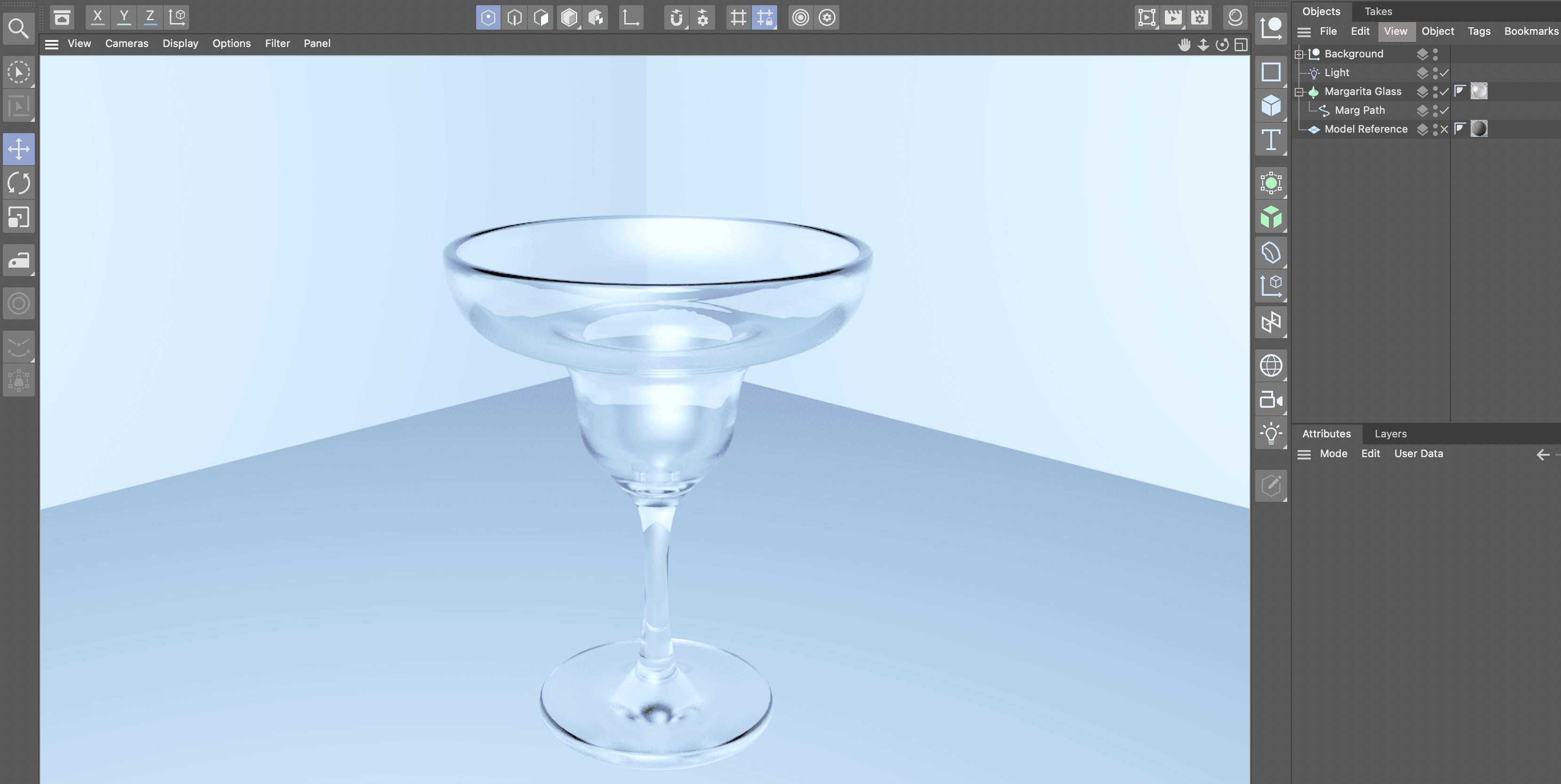
Exercise Overview
In this exercise you’ll learn how to create a 3D model in C4D using spline modeling techniques such as loft, lathe, and extrude.
Previewing the Final Image
Let’s see a preview of what you’ll be making. If you’re in After Effects, keep it open but switch to your Desktop.
On the Desktop, navigate to Class Files > C4D in AE Class > Creating 3D Models > Preview Movie and double–click Margarita Glass.jpg.
-
Notice the following:
- There is a margarita glass sitting in the middle of a simple scene.
- The glass has a realistic texture.
Replay the video if you need to, and close it when done.
Getting Started
In this part of the lesson, we will be creating a 3D model from scratch directly in Cinema 4D
Open Cinema 4D Lite.
If you are just opening the application close the Quick Stat Dialog.
In C4D Lite, if you have a project open, choose File > Save.
Choose File > Close All Projects.
Choose File > Save Project As
Navigate to C4D in AE Class > Creating 3D Models
Name the file Your Name—Margarita Glass.c4d
Press Save. We’re now ready to begin.
Understanding Spline Modeling
In 3D modeling applications, spline modeling is one of several ways to create 3D geometry and is currently the only way of creating 3D objects in Cinema 4D Lite. A spline is basically just the technical term for what most Adobe programs call a path and what After Effects calls a mask. It is a series of vertices (most Adobe programs call them anchor points) connected by line segments to form a continuous line. Modifiers such as Extrude, Loft, and Lathe can then be used to convert the lines (which have no 3D form) into three dimensional geometry.
Types of Spline Objects
In the Create menu, press and hold (long press) on the Rectangle to reveal the other shapes available to you.
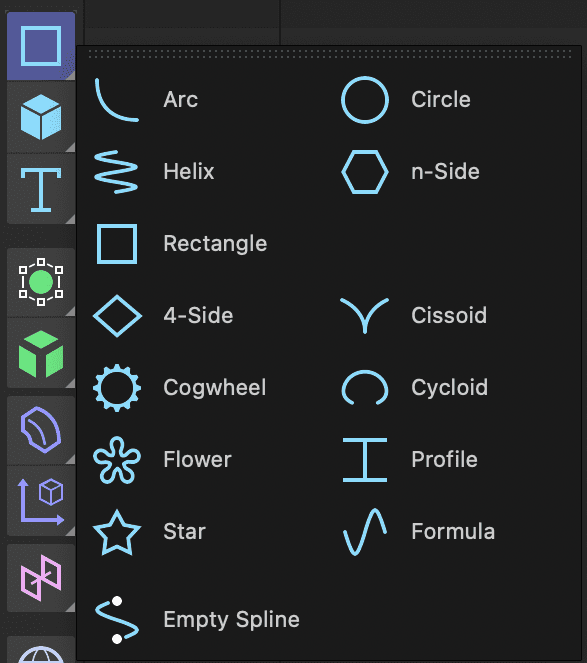
Cinema 4D Lite can create a wide range of primitive spline objects: Arc, Helix, Rectangle, 4-side, Cogwheel, Flower, Star, Circle, n-Side, Cissoid, Cycloid, Profile and Formula. Additionally, custom spline objects can be created using the Spline Pen  .
.
Creating a Reference for Modeling
When modeling it is usually helpful to have some type of drawing as a reference. A helpful technique is to use your reference as the texture on a plane and then use that as your reference.
-
In the Create Menu press and hold the Cube button to reveal the other primitive shapes.
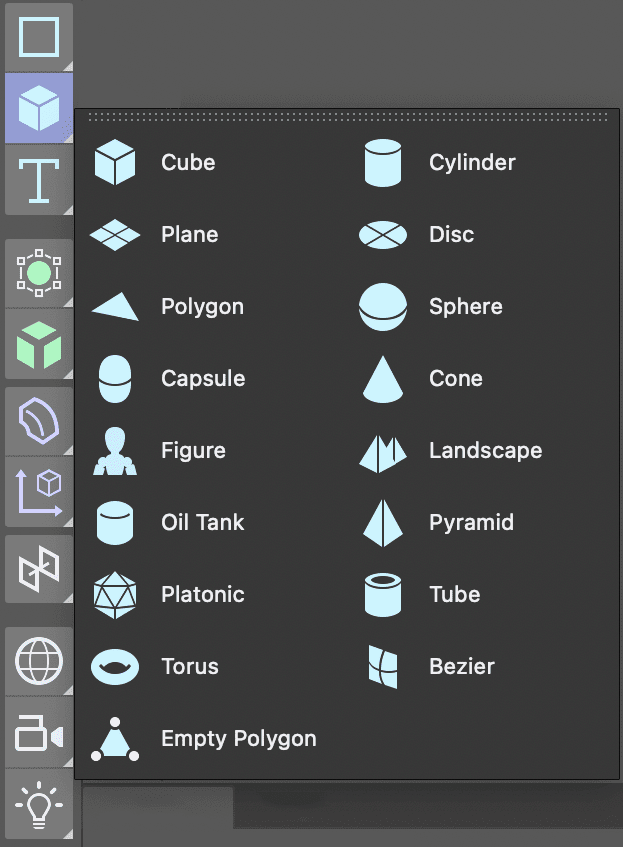
Select the Plane object from the list.
In the Perspective viewport click on the Toggle Active View
 button to reveal all four viewports.
button to reveal all four viewports.In the Object Manager double–click on the Plane and rename it Model Reference.
With the Model Reference object selected click on the Coord. tab in the Attribute Manager.
-
Change R.P to 90
This will rotate the plane so it faces forward in the Front view.
-
Still in the Attribute Manager click on the Object tab and change:
- Width to 1080
- Height to 1920
NOTE: Why are we using 1080 X 1920 for the size of the plane. Those are the dimensions of the image we are going to use as a reference. Creating a plane so it’s the same siaze as your reference image will avoid problems later.
-
Click in the Front view and press H or choose View > Frame Geometry.
- Repeat this for the other viewports.
In the Front viewport choose Display > Gouraud Shading. This will allow us to see the texture in the Front viewport once we apply it.
Click on the Material Manager
 button to open it.
button to open it.Click on the New Default Material
 button.
button.-
Double–click on the new material’s name and rename it Model Reference.
- Press Return (Mac) or Enter (Windows) or click on any empty space to finalize the name change.
Double–click on the material’s icon
 to open the Material Editor.
to open the Material Editor.In the Material Editor turn off the switch next to Reflectance.
Click on the Color map to make sure it’s active.
Click the arrow next to texture and choose Load Image.
Navigate to C4D in AE Class > Creating 3D Models > Media > Images.
-
Double–click on Reference—Margarita Glass.png. Click No in the dialog that appears.
NOTE: Becasue this image isn’t in the same root folder as our C4D file the application gives us the opportunity to make a copy of it there. This way we are less likely to misplace or move the files which would result in problems rendering later.
Close the Material Editor.
Drag the material from the Material Manager onto the Model Reference plane in the Object Manager.
Click the Material Manager button again to close it.
In the Object Manager click on the Model Reference object to select it.
In the Attribute Manager click on the Coord. tab.
-
Change the P.Z attribute to 100
This places the plane behind the spot in the scene where new objects are created and should make tracing it later a bit easier.
In the Front viewport, click the Toggle Active View
 to hide the other views. We are going to create our model entirely in the front view.
to hide the other views. We are going to create our model entirely in the front view.-
For better organization we are going to place the reference image on its own layer.
- In the Object Manager CTRL–click (Mac) or Right–click (Windows) on the Model Reference object.
- Choose Add to New Layer. Notice that the little shape to the right of your object’s name lights up.
-
Locate the Layer Manager, it’s the panel named Layers.
- Double–click the new layer and rename it Reference.
- Click on the lock located beneath the L label.
NOTE: Each of the letter labels controls a diffrent property of the layer, the S solos the layer content, the V controls its visibility, etc. To see what each label represents choose open the View menu in the Layer Manager.
Click back on the Attribute Manager tab to reveal it. When a layer is selected this panel allows you to set its options.
Press Cmd–S (Mac) or CTRL–S (Windows) or choose File > Save Project.
Creating a Spline with the Spline Pen
In this section of the lesson we will use the Spline Pen tool to create the path that will eventually become the Margarita glass.
If You Did Not Do the Previous Exercises
If a project is open in Cinema 4D, go to File > Save Project, then File > Close All Project.
Go to File > Open Project and navigate to Desktop > Class Files > C4D in AE Class > Creating 3D Models > Finished Projects.
Double–click on Margarita Glass—Reference.c4d.
Go to File > Save Project As. Name the file Your Name—Margarita Glass.c4d and save it to Desktop > Class Files > C4D in AE Class > Creating 3D Models (replacing the file if it’s already there).
Click on the Spline Pen
 tool to the left of the viewport.
tool to the left of the viewport.In the Front view, hold the 2 key on your keyboard and drag the Left Mouse button to zoom in until you can comfortably see the reference image.
-
Click at the blue center line where it crosses over the center of the glass to create the first vertex, then click to create a second vertex about half way up the interior of the glass.
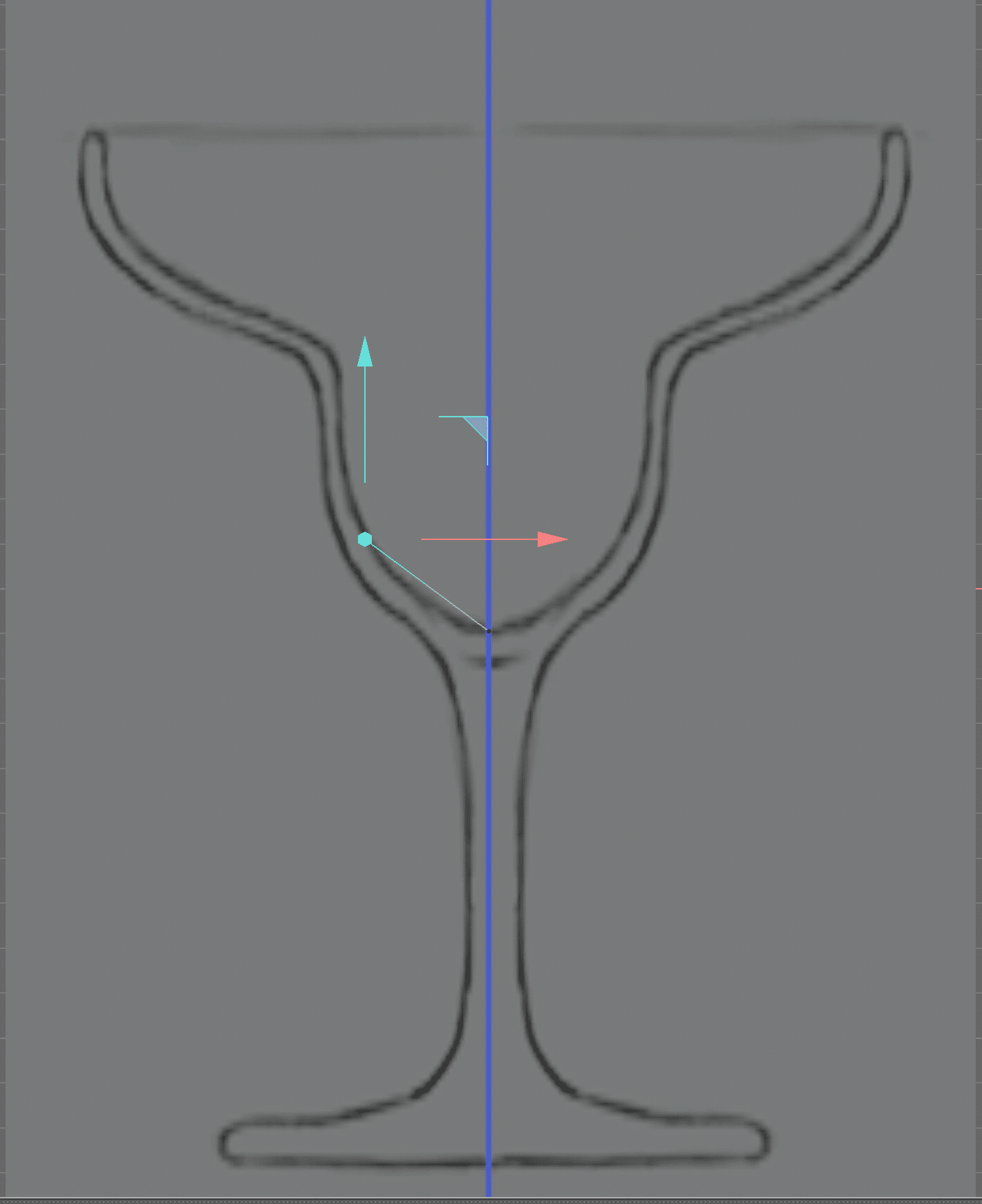
-
Continue to create a series of straight lines until you have the rough contour of the glass created.
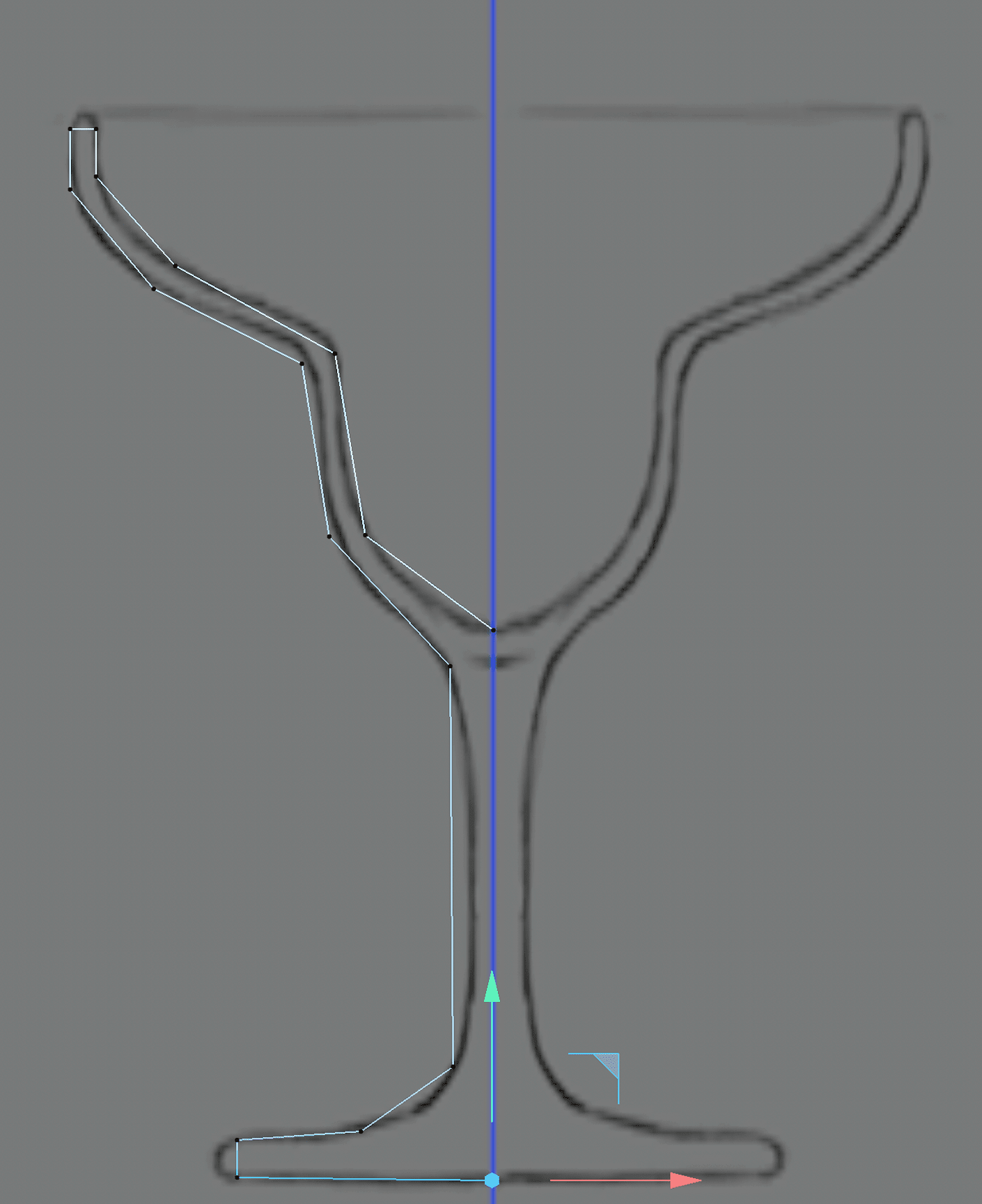
Press the Esc key on your keyboard to finalize the spline.
Press the Spacebar on the keyboard to switch to the Live Selection
 tool.
tool.-
Drag the live selection tool over all the vertices on the spline to select them.
NOTE: The vertices turn white when they are selected.
-
CTRL–click (Mac) or Right–click (Windows) on one of the selected vertices and choose Soft Interpolation.
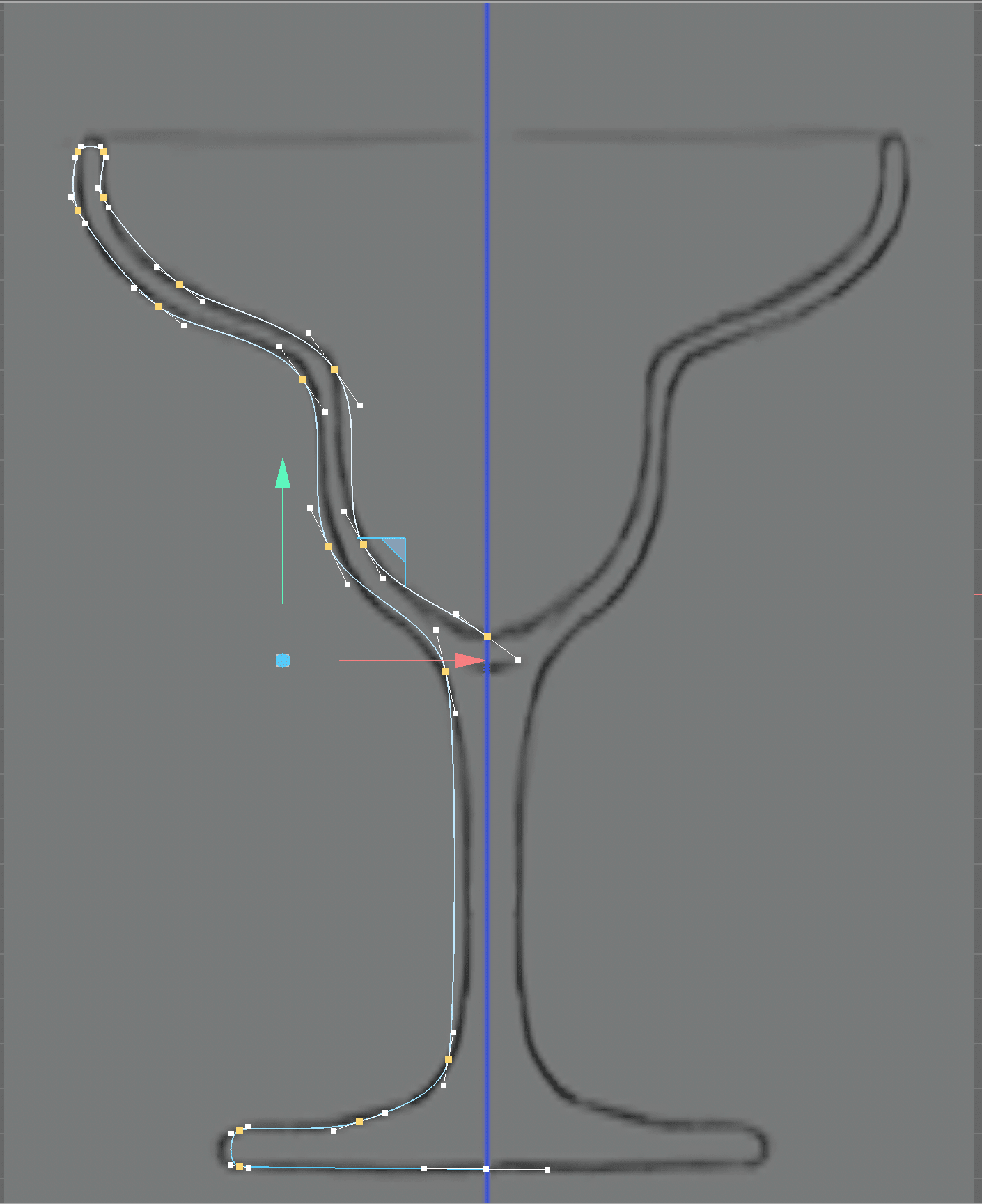
Press E to activate the Move tool.
Click on the vertex at the center line along the top of the glass.
-
Drag this vertex’s tangent lines until the curve looks more like the reference image.
NOTE: You can also use the Move tool to move vertices around.
-
Continue to adjust vertices and tangents until you are happy with the results.
NOTE: To break Tangents so they are no longer linked together hold the Shift key while dragging. To delete a vertex, select it and press Delete (Mac) or Backspace (Windows) on your keyboard.
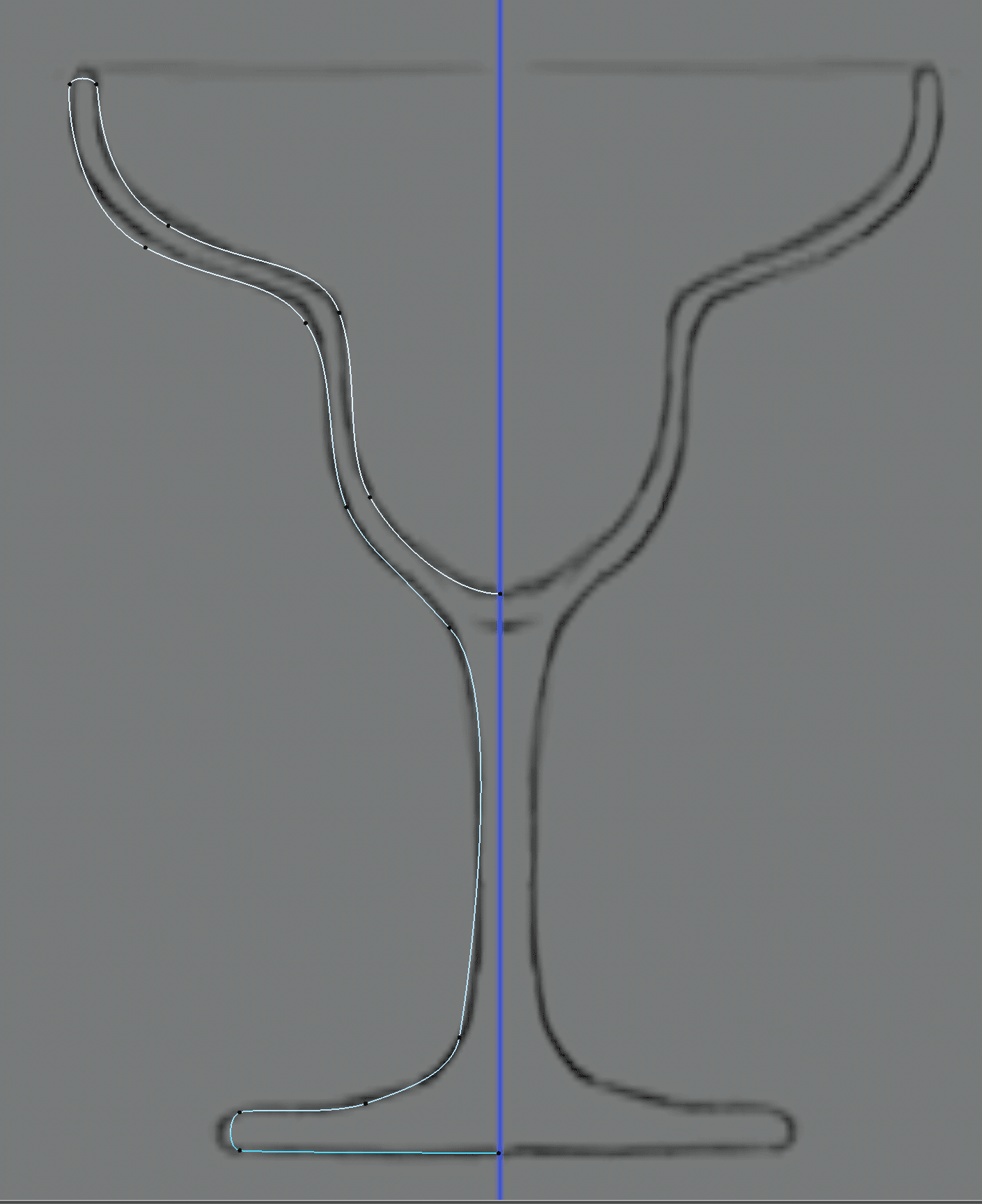
Press Cmd–S (Mac) or CTRL–S (Windows) or choose File > Save Project.
Creating a Lathe Object
The Lathe object is one of the modifiers in C4D to create 3D geometry from a 2D spline. The lathe is good for any object that has a central axis like a cup, bowl, or in this case a margarita glass.
If You Did Not Do the Previous Exercises
If a project is open in Cinema 4D, go to File > Save Project, then File > Close All Project.
Go to File > Open Project and navigate to Desktop > Class Files > C4D in AE Class > Creating 3D Models > Finished Projects.
Double–click on Margarita Glass—Spline.c4d.
Go to File > Save Project As. Name the file Your Name—Margarita Glass.c4d and save it to Desktop > Class Files > C4D in AE Class > Creating 3D Models (replacing the file if it’s already there).
In the Object Manager click off the check mark to the right of Model Reference to hide it.
Still in the Object Manager double–click on the Spline object and rename it Marg Path.
-
Hold the Option (Mac) or ALT(Windows) and click on the Subdivision Surfacemodifier in the Createtools and choose Lathe**.
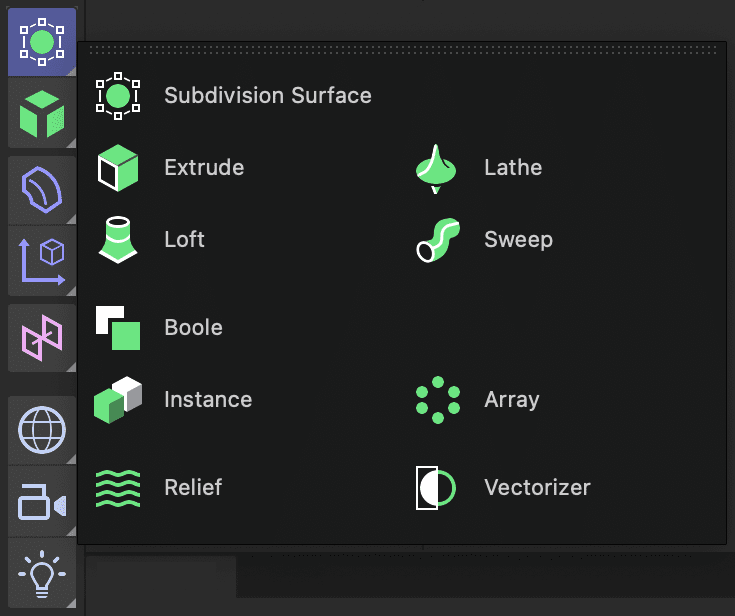
NOTE: Holding down the keyboard modifier key adds Lathe as the parent of the currently selected object. This automatically applies it to create the new shape.
Click on the toggle Active View
 button to view all four viewports.
button to view all four viewports.-
In the Perspective view, adjust the window until you can see the top of the glass clearly.
NOTE: You can hold down the 1,2, & 3 keys on the keyboard and drag in the window with left mouse buttons to use the Move, Scale, and Orbit camera tools.
The shape of the glass is a little rough, we can fix this using the Subdivision attribute in the Lathe object.
-
In the Object Manager, double–click on the Lathe object and rename it Margarita Glass.
- Press Return (Mac) or Enter (Windows) on the keyboard to finalize the change.
With the Margarita Glass object selected click on the Object tab in the Attribute Manager.
-
Change Subdivisions to 50. This will give the glass a smoother look.
NOTE: If you need to adjust the spline more you can just turn off the lathe object, click on the spline and use the move tool to adjust it. Remember to turn the lathe back on when you are done.
Click in each other viewport and press H on your keyboard to fit the geometry in the view.
-
In the Front view choose Display > Lines.
NOTE: You can also hold the N key on the keyboard and press G to switch to the lines display mode.
Press Cmd–S (Mac) or CTRL–S (Windows) or choose File > Save Project.
Creating Lights
The default lighting in the C4D scene isn’t bad, but for the glass material we are going to add in a bit our own custom lights should work better.
-
Long press on the Light object to reveal the light types you can create.
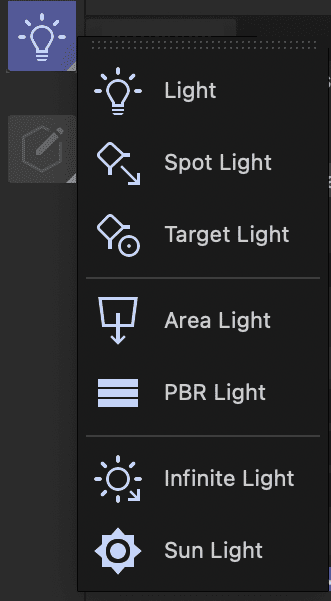
Choose Light from the list to create a default omni directional light.
Press E to activate the Move tool.
-
In the Top and Perspective views move the light around so it fully illuminates the front (based on your perspective view) of the glass.

Click in the Perspective view to make it active.
Press and hold the Render View
 button at the top of the viewports.
button at the top of the viewports.Choose Interactive Render Region.
-
Adjust the render region in the Perspective view so that is covers the entire glass.
Adjust the quality slider to whatever your computer can preview well.
Click on the Perspective window’s Toggle Active View
 button to make it the only viewport.
button to make it the only viewport.Click on the Light in the Object Manager to select it.
Click on the General tab in the Attribute Manager.
-
Make sure the light color is set to HSV and set:
- H : 215
- S : 40
- V : 90
This gives the light a blueish color and helps to cool off the entire scene.
Press Cmd–S (Mac) or CTRL–S (Windows) or choose File > Save Project.
Creating a Simple Background
Before we create the texture for the glass, we are going to create a little scene with a floor and two walls. We are adding a background to make it easier to see the model once we have added the glass texture. If you wanted to you could leave the background blank, use a single simple plane as your background, or create a more intricate one using a variety of techniques.
Long press on the Rectangle object in the Create menu and choose Plane.
In the Attribute Manager click on the Object tab and change the Width and Height to ,000
Double–click on the plane object and rename it Floor.
Press E on the keyboard to activate the Move tool.
In either the Right or Front views drag the plane down to the bottom of the glass.
-
In the Object Manager click on the Floor object:
- Press Cmd–C (Mac) or CTRL–C (Windows) to copy the floor.
- Press Cmd–V (Mac) or CTRL–V (Windows) to paste the object creating Floor.1
Click on the Coord. tab in the Attribute Manager and change R.P to 90
In the Top or Right viewports drag the new plane so it is behind the glass.
Press Cmd–V (Mac) or CTRL–V (Windows) again to paste another copy of the floor object, creating Floor.2
-
In the Coord. tab of the Attribute Manager change:
- R.P = 90
- R.B = 90
In the Top or Front views drag the new plane so it is also behind the Glass.
-
In the Object Manager change:
Floor.1 to Wall.1 Floor.2 to Wall.2
Select Floor, Wall.1 and Wall.2 and press Option–G (Mac) or ALT–G (Windows) to group them together into a new null.
Double Click on the new null and rename it Background.
CTRL–click (Mac) or Right–click (Windows) on the Background object and choose Add to New Layer from the menu.
-
In the Layer Manager double-click on the new layer and rename it Background.
- Click off the eye switch under the V label. This should turn off the visibility of all content on this layer. Notice that the planes are still visible.
- Turn the layer’s Eye switch back on.
NOTE: In C4D adding a parent object to a layer does not automatically add its children.
-
In the Object Manager select Floor, Wall.1 and Wall.2 and CTRL–click (Mac) or Right–click (Windows) on one of them.
- Choose Add to Layer > Background.
- Return to the Layer Manager and flip the visibility switch for the Background layer off and on a couple of times to see the result.
Press Cmd–S (Mac) or CTRL–S (Windows) or choose File > Save Project.
Creating and Adding Textures
In this part of the lesson, well make a glass texture to apply to the margarita glass.
CLick on the Material Manager
 button to open it.
button to open it.Click on the New Default Material
 button.
button.-
Double–click on the new material’s name and rename it Glass.
- Press Return (Mac) or Enter (Windows) or click on any empty space to finalize the name change.
Drag the Glass material onto the Margarita Glass Lathe object in the Object Manager.
Double–click on the material’s icon
 to open the Material Editor.
to open the Material Editor.Click on the Color map to make it active.
-
Make sure the color mode is set to HSV and change the color so that:
- H = 200
- S = 64
- v = 100
Click on the witch next to Transparency to enable it.
Click on Reflectance to make it active.
Click the Remove button at the top of the reflectance attributes to delete the default reflection map.
Click Add and choose Beckman from the list.
-
Click on the arrow next to Layer Fresnel and set:
- Fresnel : Dielectric
- Preset : Glass
- Strength : 85
- IOR : 1.5
-
In the Beckman attributes above set:
- Roughness : 46
- Reflection Strength : 92
- Specular Strength : 33
Close the Material Editor and Material Manager
Turn off the *Interactive Render Region.
Press Cmd–R (Mac) or CTRL–R (Windows) to render the perspective view.
-
Press Cmd–S (Mac) or CTRL–S (Windows) or choose File > Save Project.
You can close this project now. You have completed this section of the lesson.


